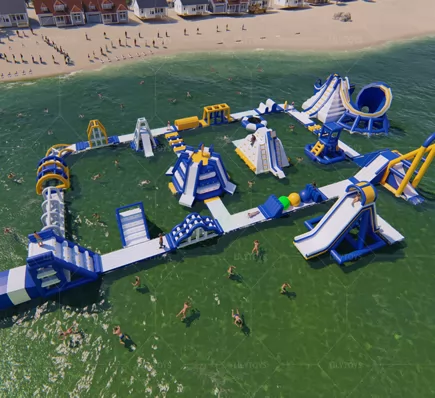As a parent, it's important to know what to look for if you're planning a trip to an indoor or outdoor inflatable water park.
Here's some information and reminders from LilyToys to help keep your family safe and healthy.
1. Know the rules.
Inflatable water slides are the number one cause of water park injuries. Therefore, please follow the ride route. Rules like "feet first" are in place for a reason - to keep riders safe.
Many people visit hospitals for waterpark-related injuries, the most common of which are bruises, cuts, fractures, concussions and spinal injuries.
Always be aware of the size and weight limits of waterpark rides. Riders who are too small may be thrown from the ride. Riders exceeding the maximum may get stuck in the chute or go too fast and exit the ride too soon. Also, please note the maximum number of riders allowed. If the sign says limited to two riders per ride, please don't stack up four just to break the record. Make sure your child understands the need to follow the rules.

2. Know your swimmers.
National data shows that fatal and non-fatal drownings have occurred at water parks. It can happen to anyone. Know the risks and take steps to prevent drowning tragedies.
Which water park has the greatest risk of drowning?
The answer is: wave pools. Wave pools can be dangerous for young children or weaker swimmers and can become confusing with large numbers of people floating in the water. It also makes it very difficult to spot troubled swimmers who may appear to be just another swimmer enjoying the waves. Close parental supervision is even more important. Parents, stay out of reach of young or frail swimmers. Watch your child and strongly consider having your swimmer wear a life jacket. 3.
3. Know what's in the water.
Most people have about 0.14 grams of fecal matter in their bottom that can be flushed out and contaminate the water. The CDC also reports that in one year, 58% of public pools tested positive for E. coli - a marker of fecal contamination. Yuck! Crypto (short for Cryptosporidium) is highly tolerant to chlorine, allowing the parasite to survive in chlorinated pool water for extended periods of time. Both E. coli and Crypto can make swimmers very sick, sometimes leading to hospitalization.
● What parents can do to prevent waterborne illness.
● Teach your child never to drink pool water. If your child is thirsty, provide clean drinking water.
● Take your child to the bathroom about once an hour.
● Check swim diapers every 30-60 minutes.
● Avoid sitting on the water jet.
● If your child is sick - especially with diarrhea - don't go to the water park.
● Showering before swimming, especially if your child has been playing in other areas of the inflatable water park (such as the sandbox), can help rinse bacteria from the skin and reduce contamination.
● Take another shower before you go home. This will remove chlorine from the skin and help prevent skin irritation.
4. Think outside the pool.
So now that you've considered swimming rules, swimmer safety and health issues, there are some more general tips to help ensure you stay active during your day at the park. As always, if you're outdoors, it's important to carry and use sunscreen. You should also bring water to keep everyone hydrated.
Here are some more ideas to keep everyone feeling safe and happy.
● Water shoes are a good investment for both indoor and outdoor parks. Pool deck surfaces can become slippery from the mix of water and sunscreen. Water shoes can provide extra traction for little feet and protect them from rough surfaces such as the bottom of the pool.
● Schedule activity breaks throughout the day. Children burn about 288 calories per hour while playing in the pool. This level of activity can tire young swimmers, so it's important to get out of the water and rest regularly. This is a good time to enjoy a snack and take a bathroom break in the shade.
● Walk, don't run. The pool deck is slippery and the park can become crowded.
● Get a map of the park and identify meeting places in case your family gets separated.
● Children and others who lack strong swimming skills should also wear life jackets when in a pool or inflatable water park. Some parks require swimmers to wear these devices, and staff can help you make sure they are the right size and fit your child. Even if they are wearing life jackets, young children and those who can't swim need touch supervision from an adult who can swim within arm's reach.
● Remember, lifeguards are only one layer of drowning prevention. Close, attentive, competent supervision is essential when your child is in or around the water. Even if they are wearing life jackets, young children and those who cannot swim need touch supervision from an adult who can swim within reach.





